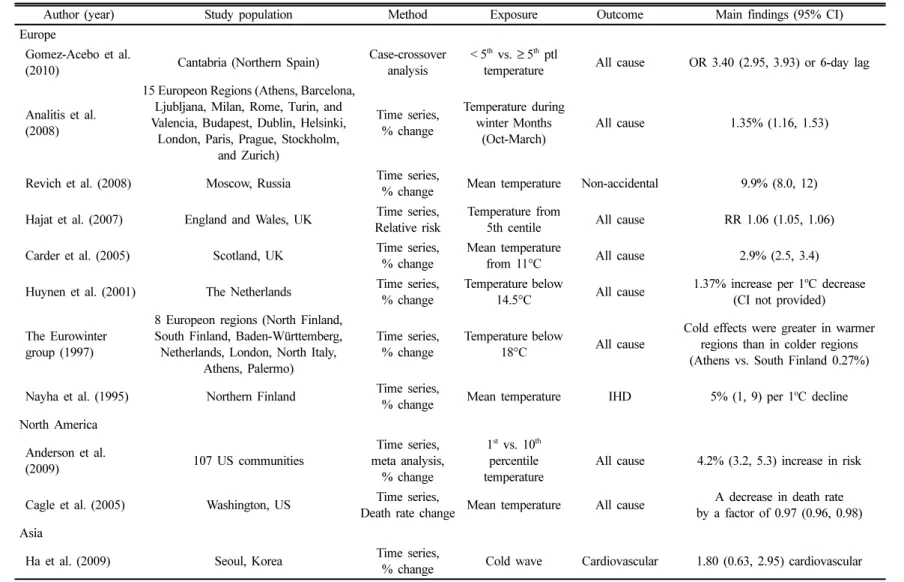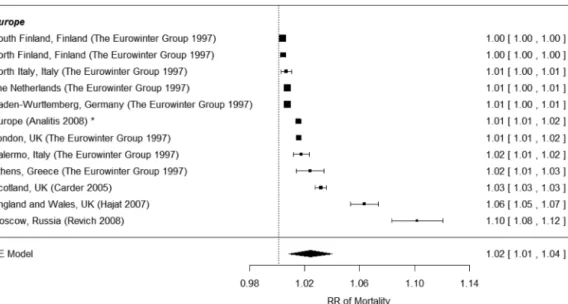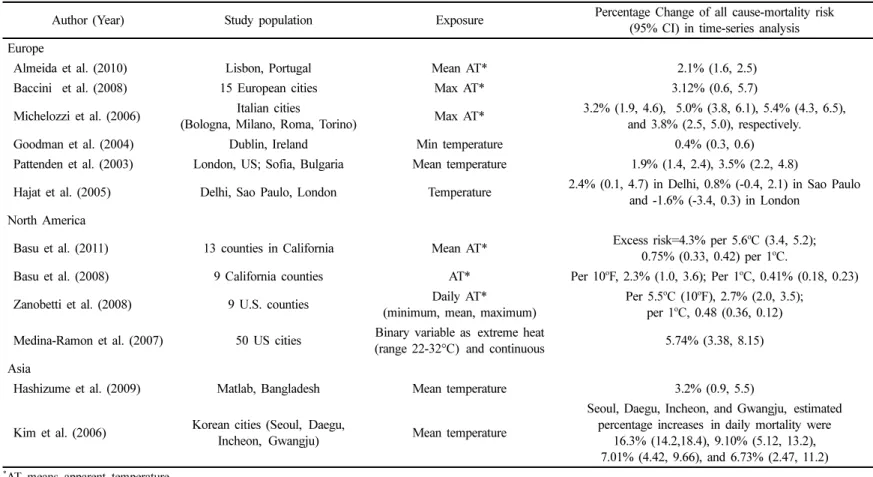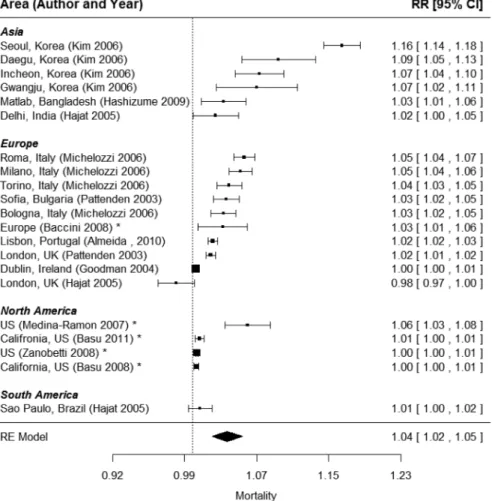기후변화와 건강 − 저온과 고온이 사망에 미치는 영향에 관한 체계적 고찰
임연희*·김 호**
*서울대학교 보건환경연구소, **서울대학교 보건대학원
Climate Change and Health − A Systemic Review of Low and High Temperature Effects on Mortality
Youn-Hee Lim* and Ho Kim**
*Institute of Health and Environment, Seoul National University, Seoul, Korea
**Graduate School of Public Health, Seoul National University, Seoul, Korea
ABSTRACT
Objectives: The impact of climate change on the health has been of increasing concern due to a recent temperature increase and weather abnormality, and the research results of the impact varied depending on regions. We synthesized risk estimates of the overall health effects of low and high temperature taking account of the heterogeneity.
Methods: A comprehensive literature search was conducted using PUBMED to identify journal articles of low and/or high temperature effects on mortality. The search was limited to the English language and epidemiological studies using time-series analysis and/or case-crossover design. Random-effect models in meta analysis were used to estimate the percent increase in mortality with 1oC temperature decrease or increase with 95% confidence intervals (CI) in cold or hot days.
Results: Twenty three studies were presented in two tables: 1) low temperature effects; 2) high temperature effects on mortality. The combined effects of low and high temperatures on total mortality were 2% (95% CI, 1-4%) per 1oC decrease and 4% (95% CI, 2-5%) per 1oC increase of temperature, respectively.
Conclusions: This meta analysis found that both low and high temperatures affected mortality, and the magnitude of high temperature appeared to be stronger than that of low temperature.
Keywords: Climate change, High temperature, Low temperature, Meta analysis, Mortality
I. 서 론
최근의 기상이변으로 인하여 언론매체 뿐 아니라 학계에서도 기후변화에 대한 관심이 커지고 있다. 특 히 기상이변 혹은 기온이변으로 인한 건강영향에 대 한 연구들이 많이 발표되고 있다. 기후변화로 인한 직접적인 영향에는 고온, 저온, 혹은 일교차 등에 의
한 건강영향이 있으며, 간접적인 영향으로는 기온상 승으로 인한 전염성 질환의 증가, 각종 재해로 의한 피해의 증가, 후진국에서의 식량문제 등이 있다.1) 이 연구에서는 기온의 변화에 따라 사망에 미치는 영향 을 중심으로 살펴보고자 한다.
기후변화를 야기하는 원인은 다양하지만 그중 주 목받고 있는 것은 엘니뇨 현상이다.2)엘니뇨 현상은
†Corresponding author: Graduate School of Public Health, Seoul National University, Seoul 151-742, Korea, Tel: +82-2-880-2711, Fax: +82-2-762-2888, E-mail: hokim@snu.ac.kr
Received: 6 December 2011, Revised: 12 December 2011, Accepted: 27 December 2011
J Environ Health Sci 2011: 37(6): 379-405 http://www.kseh.org/
무역풍 등의 영향으로 차가운 해수가 흐르지 못해 해수의 온도가 높은 상태로 유지되는 현상이다. 평 상시에는 적도 해상에서는 동풍인 무역풍이 부는데 이 무역풍이 약화되면서 동쪽에서 서쪽으로 흐르는 해류가 줄게 된다. 따라서 동태평양에 차가운 심층 수가 올라오지 않아 태평양의 수온이 올라가므로 대 류활동이 중앙태평양으로 옮겨지게 된다. 태평양의 해수와 온도가 높아지면 강수량과 바람장이 변하고 동태평양의 수온약층이 깊어진다. 이 과정이 반복되 면 해수면의 온도가 계속 올라가게 되는데 이런 현 상을 엘니뇨라고 한다. 엘니뇨와 반대로 수온이 차 가워지는 현상을 라니냐라고한다. 엘니뇨와 라니냐 는 단순히 바닷물의 온도변화에 머물지 않는다. 온 도변화에 따라 해양과 대기의 흐름이 달라져 기후현 상 전반에 영향을 주게 되며 이로 인하여 이상기상 현상이 일어나거나 질병의 발생양상에도 영향을 줄 수 있다.3,4) 이외에도 오랫동안 알려진 이론은 환경 오염으로 인한 기후변화이다. 대기 중 가스배출로 인 하여 탄소배출이 증가하고 이에 따라 온실현상이 초 래하여 기온이 증가한다는 것이다.5)
기후변화에 관한 정부간 패널(Intergovernmental Panel on Climate Change, IPCC)보고서는 21세기 동안 온실가스 영향으로 기온은 1-4oC 증가한다고 예측하고 있으며 이러한 기온상승은 전세계적인 추 세이다.6) 기온상승에 대한 관심이 높아지면서 고온 에 대한 건강영향평가는 유럽, 아시아, 북, 남미 아 메리카에서 많이 수행되어 왔다. 저온에 대한 연구 는 유럽을 위주로 이루어졌으며, 미국, 아시아에서도 몇 차례 이루어져왔다.7,8) Basu와 Samet(2002)은 고 온의 영향에 대하여 지역별 차이와 취약그룹이 있다 고 보고하고 있다.9)
신체가 저온에 노출이 되면 몇 가지의 단계적 생 리반응이 초래된다. 첫째, 외부의 낮은 온도로 인한 열손실을 막고 신체의 주요기관에 산소공급을 원활 하게 하기 위해 피부혈관수축이 일어난다. 저온상태 가 지속되면 겉표면에 열을 전달하기 위해서 신체온 도는 떨어진다. 따라서 신체 내의 열을 발생시키기 위해서 근육 수축, 오한, 심박동수 증가, 호흡 속도 증가 등이 일어나며, 차가운 공기의 흡입을 통해서 기관지 수축이 일어난다.10,11)몸이 차가워지는 속도 는 차가운 물 속에 들어갔을 때는 몇 분안에 일어 나지만, 일반적인 경우에 발생하는 저온에 의한 체
온감소는 몇 주가 걸릴 수도 있다.12)
고온에 노출이 되면 신체 표면의 혈액순환이 활발 해지고, 반사, 전달, 발한으로 신체의 냉각속도를 높 여준다.13)혈액순환을 활발하게 하는 과정에서 심장 에 무리가 가고 이로 인하여 심장 박동, 혈관 내의 부피 등이 증가하고, 신장과 내장의 혈관수축이 지 속적으로 발생한다. 게다가, 고온이나 극단적인 열에 만성적으로 노출이 되면 온도균형을 유지하는 능력 을 잃어서 사망으로까지 이르게 된다.14) 고온에 대 한 신체의 반응은 저온보다 훨씬 더 빨리 나타나므 로 고온이 사망에 미치는 영향은 당일 혹은 그 다 음날이 최고로 높으며 시간에 지남에 따라 점차 줄 어든다.15)
고온 및 저온이 사망에 미치는 영향을 정량화하기 위해서는 두 가지 방법이 많이 사용되고 있다. 첫 번째 방법은 폭염 및 한파를 조작적으로 정의하여 서 (예를 들면, 일 최고온도가 30oC를 넘는 날이 이 틀 이상 지속되면 폭염이라고 정의, 혹은 일 최저기 온이 −10oC이하이면 한파라고 정의) 가변수를 이 용하여서 이러한 날들의 효과를 추정하는 것이다. 두 번째 방법은 기온을 연속변수로 보고 기온과 사망의 용량-반응 곡선(dose-response curve)을 추정하여 그 효과를 계산하는 것이다. 기온에 따른 사망의 관계 는 보통 U 혹은 V자 형태가 되는 것이 일반적이다.
이 경우 기온의 역치를 추정하고 역치 이상(폭염의 경우) 혹은 이하(한파의 경우)에서의 기울기를 온도 의 효과로 사용하게 된다. 이 연구에서는 두 번째 방법으로 연구 결과를 제시한 논문들의 결과를 사용 하는 것을 원칙으로 하였다. 첫번째의 경우 폭염 및 한파의 정의가 연구마다 상이하므로 메타분석방법을 적용하는 것이 무의미하기 때문이다.
기후변화의 패턴이 지역에 따라서 다양하게 나타 나듯이 고온과 저온의 건강영향도 지역별로 다르게 나타난다.15,16) 이러한 다양성을 고려하여 통합효과를 보기 위한 방법인 메타분석은 환경역학에서 많이 이 용되고 있는 방법이다.16-18)이 연구는 기존에 게재된 논문들을 메타분석으로 종합하여 여름철 고온과 겨 울철 저온으로 인한 건강영향을 고찰하고자 수행되었다.
II. 연구 방법
고온과 저온이 사망에 미치는 영향에 관한 기존의
기후변화와 건강 - 저온과 고온이 사망에 미치는 영향에 관한 체계적 고찰
://www.kseh.org/JEnvironHealthSci2011:37(6):397-405
Table 1. Recent studies of cold effects on mortality
Author (year) Study population Method Exposure Outcome Main findings (95% CI)
Europe
Gomez-Acebo et al.
(2010) Cantabria (Northern Spain) Case-crossover
analysis
< 5th vs. ≥ 5th ptl
temperature All cause OR 3.40 (2.95, 3.93) or 6-day lag
Analitis et al.
(2008)
15 Europeon Regions (Athens, Barcelona, Ljubljana, Milan, Rome, Turin, and Valencia, Budapest, Dublin, Helsinki,
London, Paris, Prague, Stockholm, and Zurich)
Time series,
% change
Temperature during winter Months
(Oct-March)
All cause 1.35% (1.16, 1.53)
Revich et al. (2008) Moscow, Russia Time series,
% change Mean temperature Non-accidental 9.9% (8.0, 12) Hajat et al. (2007) England and Wales, UK Time series,
Relative risk
Temperature from
5th centile All cause RR 1.06 (1.05, 1.06)
Carder et al. (2005) Scotland, UK Time series,
% change
Mean temperature
from 11°C All cause 2.9% (2.5, 3.4)
Huynen et al. (2001) The Netherlands Time series,
% change
Temperature below
14.5°C All cause 1.37% increase per 1oC decrease (CI not provided)
The Eurowinter group (1997)
8 Europeon regions (North Finland, South Finland, Baden-Württemberg, Netherlands, London, North Italy,
Athens, Palermo)
Time series,
% change
Temperature below
18°C All cause
Cold effects were greater in warmer regions than in colder regions (Athens vs. South Finland 0.27%)
Nayha et al. (1995) Northern Finland Time series,
% change Mean temperature IHD 5% (1, 9) per 1oC decline North America
Anderson et al.
(2009) 107 US communities
Time series, meta analysis,
% change
1st vs. 10th percentile temperature
All cause 4.2% (3.2, 5.3) increase in risk
Cagle et al. (2005) Washington, US Time series,
Death rate change Mean temperature All cause A decrease in death rate by a factor of 0.97 (0.96, 0.98) Asia
J Environ Health Sci 2011: 37(6): 379-405 http://www.kseh.org/
논문 결과들을 이용하여 메타분석을 한다.
PUBMED (www.ncbi.nlm.nih.gov)의 논문 중 제목 이 저온(‘cold’, ‘low temperature’) 또는 고온(‘hot’,
‘high temperature’, ‘heat’), 그리고 사망(‘death’, ‘mor- tality’)을 포함하는 논문을 선정하였다. 고온의 건강 영향에 관한 선행연구가 비교적 많이 행해졌기 때문 에 체계적인 고찰을 한 논문을 위주로 선정하였다.
그 결과 총 245편의 논문이 검색되었고, 그 중에서 영어가 아닌 외국어로 쓰여진 논문, 인간의 사망이 아닌 동물, 박테리아, 세포 등의 사망(death)과 기상 변수로써 사용된 cold가 아닌 감기나 특정온도를 명 칭하는 논문 등 적합하지 않은 주제를 제목에서 제 외하여 102개 논문을 선별하였다. 방법론의 통일성 을 위해서 population-based 자료, 시계열 분석 및 환자-교차분석방법을 이용한 논문들만 포함하여, 23 개(각 11, 12개)의 저온 및 고온으로 인한 사망영향 에 관한 논문을 최종적으로 선택하였다.
메타분석에 이용한 논문은 연구결과를 온도변화에 따른 사망의 백분율 변화량(percentage change, %) 과 95% 신뢰구간(confidence intervals, CI)이 있는 결과만 이용하였으며, 온도 1oC 상승 혹은 감소에 의한 증가백분율만을 이용하였다. 1oF 혹은 10oF으 로 제시된 결과는 1oC증가 백분율로 환산하여 제 시하였다. 메타분석은 R software (cran.r-project.org)
의 metafor패키지를 이용하였다. 이질성 검정 (Heterogeneity test)은 Q-통계량(Q-statistics)의 p-값 이 0.05 수준에서 유의한지를 보았으며, 출판오류 (publication bias)는 순위상관검정(rank correlation test)을 이용하여서 p-값이 0.05 수준에서 유의한지 를 보았다.
III. 결 과
저온으로 인한 사망은 고온에 의한 영향보다는 연 구가 많이 보고되지 않았다. 선택한 11편의 논문 가 운데 유럽국가에서의 사망에 관한 논문은 8편, 한국 1편, 미국 2편이었다(Table 1). The Eurowinter Group 은 8개의 유럽국가들의 도시들에서 전체 사망에 미 치는 영향을 메타분석으로 통합효과를 보여줄 뿐 아 니라 각 도시별 영향을 결과로 제시하고 있다.19) Analitis 등은 15개 유럽지역에서의 겨울철(10-3월) 기온의 영향을 살펴본 후 통합효과를 제시하고 지역 의 영향을 그림으로 제시하고 있어서 정확한 지역별 효과에 대한 수치는 찾을 수 없었다.7) 개별 논문에 서 다룬 지역 중 유럽에 속하는 곳은 스페인,20) 러
시아,21) 영국,7,22,23) 네덜란드,24) 핀란드이며,19,25) 총사
망과 심혈관질환 사망에서 특정온도점 이하에서 기 온 1oC 감소할 때 1.3-9.9%의 사망이 증가하였다.
Fig. 1. Combined percentage change of relative risk of cold effects on total mortality. *combined effects.
기후변화와 건강 - 저온과 고온이 사망에 미치는 영향에 관한 체계적 고찰
://www.kseh.org/JEnvironHealthSci2011:37(6):397-405
Table 2. Recent studies of heat effects on total mortality using time-series analysis
Author (Year) Study population Exposure Percentage Change of all cause-mortality risk
(95% CI) in time-series analysis Europe
Almeida et al. (2010) Lisbon, Portugal Mean AT* 2.1% (1.6, 2.5)
Baccini et al. (2008) 15 European cities Max AT* 3.12% (0.6, 5.7)
Michelozzi et al. (2006) Italian cities
(Bologna, Milano, Roma, Torino) Max AT* 3.2% (1.9, 4.6), 5.0% (3.8, 6.1), 5.4% (4.3, 6.5), and 3.8% (2.5, 5.0), respectively.
Goodman et al. (2004) Dublin, Ireland Min temperature 0.4% (0.3, 0.6)
Pattenden et al. (2003) London, US; Sofia, Bulgaria Mean temperature 1.9% (1.4, 2.4), 3.5% (2.2, 4.8)
Hajat et al. (2005) Delhi, Sao Paulo, London Temperature 2.4% (0.1, 4.7) in Delhi, 0.8% (-0.4, 2.1) in Sao Paulo and -1.6% (-3.4, 0.3) in London
North America
Basu et al. (2011) 13 counties in California Mean AT* Excess risk=4.3% per 5.6oC (3.4, 5.2);
0.75% (0.33, 0.42) per 1oC.
Basu et al. (2008) 9 California counties AT* Per 10oF, 2.3% (1.0, 3.6); Per 1oC, 0.41% (0.18, 0.23)
Zanobetti et al. (2008) 9 U.S. counties Daily AT*
(minimum, mean, maximum)
Per 5.5oC (10oF), 2.7% (2.0, 3.5);
per 1oC, 0.48 (0.36, 0.12) Medina-Ramon et al. (2007) 50 US cities Binary variable as extreme heat
(range 22-32°C) and continuous 5.74% (3.38, 8.15) Asia
Hashizume et al. (2009) Matlab, Bangladesh Mean temperature 3.2% (0.9, 5.5)
Kim et al. (2006) Korean cities (Seoul, Daegu,
Incheon, Gwangju) Mean temperature
Seoul, Daegu, Incheon, and Gwangju, estimated percentage increases in daily mortality were
16.3% (14.2,18.4), 9.10% (5.12, 13.2), 7.01% (4.42, 9.66), and 6.73% (2.47, 11.2)
*AT means apparent temperature.
J Environ Health Sci 2011: 37(6): 379-405 http://www.kseh.org/
Ha 등은 서울에서 한파로 인한 심혈관질환 사망이 증가한다고 하였다.26) Anderson 등이 연구한 미국 107 개 지역의 온도 1th와 10th퍼센타일(percentile)을 비 교했을 때, 극한에서 4.2%의 총사망이 증가하였다.27) 미국의 Cagle 등의 워싱턴주의 연구 결과에서는 기 온 5oC감소할 때마다 사망이 0.97명 증가한다고 하 였다28). Table 1에서 선정된 논문 중 3편은20,27,28) 기 온 1oC 변화에 의한 사망의 백분율 변화량을 결과 로 제시하고 있지 않아서 메타분석에서는 포함시키 지 않았다. 또한, 2편의 논문은 건강 결과가 총사망 이 아닌 심혈관질환으로 인한 사망이였으며,25,26) Huynen의 논문은 CI를 결과로 제시하고 있지 않아 서24) 이 3편의 논문들도 메타분석에 포함시키지 않았다.
Fig. 1은 시계열 분석을 이용한 논문 중에서(유럽 에서만 5개) 기온과 총사망의 연관성을 백분율 증가
분으로 보여주는 메타분석 결과이다. 기온 1oC 증가 할 때 총사망은 2%(95% CI, 1-4%) 증가하는 것으 로 나타났다. 이질성 검정에서는 대상논문의 결과들 은 유의하게 다르며(P-value < 0.0001), 약간의 출판 오류의 가능성이 보였다(P-value = 0.0629).
Table 2는 2000년도 이후 고온으로 인한 총사망의 영향을 시계열 분석을 이용하여 백분율 증가로 표시 한 연구 결과들만 정리하였다. 12개의 논문 중에서 미국과 유럽이 각각 4, 6편의 결과를 보여주었으며, 나머지는 아시아 및 기타 지역이었다. 고온의 연구 에서는, 절대온도를 사용한 저온연구와는 달리 체감 온도(Apparent Temperature, AT)를 살펴본 연구들이 많았다.
Fig. 2는 특정역치온도 이상에서 기온 1oC 증가할 때 총사망률의 증가를 보여주고 있다. 고온의 가장 Fig. 2. Combined percentage change of relative risk of heat effects on total mortality. *combined effects.
큰 영향을 받는것으로 나타난 지역은 서울이며,29) 유 의한 연관성을 보이지 않는 곳은 영국의 런던과 브 라질의 Sao Paulo였다.30) 고온과 총사망의 연관성을 본 아시아, 유럽, 북아메리카, 남아메리카지역의 논 문 결과를 요약하면 기온 1oC 증가할 때 4%(95%
CI, 2-5%) 총사망이 증가하는것으로 나타났다. 이질 성 검정 결과 고온으로 인한 연구 결과들은 유의한 차이가 있었으며(P-value < 0.0001), 출판 오류가 있 다고 하기는 어려웠다(P-value = 0.5306).
IV. 고 찰
이번 연구에서는 기후변화로 인한 건강영향 중에 서 저온과 고온으로 인한 총사망의 영향을 지금까지 나온 논문들을 중심으로 통합하였다.
총사망에 미치는 기온의 영향은 지역마다 다양하 게 나타났지만, 저온과 고온의 각각의 통합효과는 통 계적으로 유의하였다. 저온의 건강영향에 관한 연구 에 비하여 고온의 건강영향 연구는 많이 보고되었으 며, 고온이 저온에 비해서 총사망에 미치는 영향이 크게 나왔다(고온 4%(95% CI, 2-5%) vs. 저온 2%
(95% CI, 1-4%)). 고온의 사망영향이 저온에 비해서 높은 것은 저온에서는 난방시설의 보편화로 인하여 서 저온에 대한 대응도는 높아진 반면, 고온에 대한 대응책으로 제시되고 있는 냉방시설은 사회경제적 수준에 따라 그 분포가 다양하여져서(실제로 이 연 구에서도 저온보다 고온에서의 영향이 더 다양하였 다) 저온에서의 대응도만큼 이루어지지 않아 고온에 의한 사망영향이 더 클 수 있다.31) 이번 연구의 결 과는 고온의 건강영향을 통합한 Basu의 논문의 결 과와16) 노인에서 저온과 고온의 사망영향을 통합한 Yu의 결과와 일치한다.18) Basu는 36개의 연구를 통 합한 결과, 고온의 영향이 있으며, 특정 질병으로 인 한 사망(예, 심혈관질환), 취약그룹 계층에서 그 영 향이 크게 나왔다고 보고하고 있다. Yu는 15개의 논 문을 통합한 결과(5개의 고온의 논문, 3개의 저온, 7개의 양쪽기온) 저온과 고온이 노인의 총사망에 미 치는 영향이 각각 1-2%, 2-5%라고 하였다.
이번 연구는 몇 가지 제한점을 가지고 있다. 첫째, 기후변화로 인한 영향은 단지 총사망의 증가로만 나 타나는 것은 아니다. 특정 질병에 미치는 기온의 영 향을 고려하지 않았으므로 기온이 인체의 어떤 특정
부위에 영향을 더 미쳐서 사망에 이르게 되었는지에 대한 분석은 할 수 없었다. 또한 건강 결과를 사망 에만 국한시켰으므로, 입원, 외래 등 사망에 이르기 까지 건강악화의 일련의 과정에 대한 연구를 할 수 없었다. 향후는 세부질환으로 인한 사망 및 입원에 관한 연구가 필요하다. 둘째, 기후변화의 영향은 고 온, 저온 뿐 아니라 일교차32) 등에도 나타남을 고려 했을 때 이 연구에서는 가장 많이 이용되어지는 기 후변수만을 이용했다는 점은 제한점이다. 셋째, 기온 1oC변화당 사망의 백분율의 변화로 통합효과를 보 기 위해서 시계열 분석과 환자교차연구만을 이용한 연구 중에서 같은 형태의 결과물을 제시한 논문들만 이용하였다. 따라서 유의미한 결과를 가지고 있는 다 른 결과들은(예, 1st와 10th퍼센타일 기온의 차이27)) 통 합효과에 고려되지 않았다는 제한점이 있다. 넷째, 메타분석 결과로 통합효과를 제시하고 있는 논문들 은 그 속에 포함된 개별지역들의 기온에 따른 사망 의 백분율 변화량을 그림으로만 제시하고 있어서 개 별지역의 사망 변화량과 95% CI를 알 수 없었다.7,31,33-
36)하지만 그 외의 입력 결과들은 각 지역별 기온- 사망 관련성을 이용하였으므로 인용되는 입력 결과 들의 지역범위에 있어서 불일치가 있었다. 예를 들 면, Baccini 연구에서는 London의 저온-총사망 연관 성은 15개 유럽 도시들의 통합효과 속에 포함되어 서 입력된 반면,33) The Euronwinter Group에서 제 시한 London시의 저온에 의한 사망의 효과는 개별 효과로 입력이 되어서 메타분석에 이용되었다.19) 다 섯째, 역학연구의 필요성보다는 학문수행의 용이성 에 따라서 연구 결과가 제시되었기 때문에(예, 미국, 유럽 등 선진국) 훨씬 더 열악한 환경 가운데 거주 하는 개발도상국 및 미개지역에 대한 연구는 방글라 데시를 제외하고는 없었다.37) 추후 연구에서는 개발 도상국이나 기후변화의 피해가 치명적인 지역(예, 아 프리카 국가 혹은 북, 남극에 위치한 국가)에 대한 분석 및 고찰이 있어야 하겠다.
기후변화로 인해서 지표면의 기온이 상승하고 있 고, 이로 인한 건강피해도 늘어나고 있다. 기온상승 뿐 아니라 기온변이가 커짐에 따라서 고온과 저온으 로 인한 사망은 늘어나고 있으며, 고온으로 인한 사 망이 저온으로 인한 사망보다 크게 나타났다.
감사의 글
J Environ Health Sci 2011: 37(6): 379-405 http://www.kseh.org/
이 논문은 2010년도 정부(교육과학기술부)의 재원 으로 한국연구재단 글로벌연구실사업(No. K2100400 0001-10A0500-00710)과 기초연구사업의 지원을 받 아 수행된 연구임(No. 2010-0009581).
참고문헌
1. IPCC. Climate Change 2007: The Physical Science Basis. Cambridge and New York, Cambridge Uni- versity Press, 2007.
2. Grimm AM, Barros VR, Doyle ME. Climate Vari- ability in Southern South America Associated with El Niño and La Niña Events. J Climate. 2000; 13:
35-58.
3. Fagan BM. Floods, famines, and emperors: El Niño and the fate of civilizations. 1999. 1st ed. New York, Basic Books, 1999.
4. Kovats RS. El Niño and human health. Bulletin of the World Health Organization. 2000; 78(9): 1127- 1135.
5. Ramanathan V, Feng Y. Air pollution, greenhouse gases and climate change: Global and regional per- spectives. Atmospheric Environ. 2009; 43(1): 37-50.
6. Patz JA, Campbell-Lendrum D, Holloway T, Foley JA. Impact of regional climate change on human health. Nature. 2005; 438(7066): 310-317.
7. Analitis A, Katsouyanni K, Biggeri A, Baccini M, Forsberg B, Bisanti L, et al. Effects of cold weather on mortality: results from 15 European cities within the PHEWE project. Am J Epidemiol. 2008; 168 (12): 1397-1408.
8. Braga AL, Zanobetti A, Schwartz J. The effect of weather on respiratory and cardiovascular deaths in 12 U.S. cities. Environ Health Perspect. 2002; 110 (9): 859-863.
9. Basu R, Samet JM. Relation between elevated ambient temperature and mortality: a review of the epidemiologic evidence. Epidemiol Rev. 2002; 24 (2): 190-202.
10. McCullough L, Arora S. Diagnosis and treatment of hypothermia. Am Fam Physician. 2004; 70(12): 2325- 2332.
11. G.M B. Cold stress and cold adaptation. J Thermal Biology. 1993; 18(5-6): 629-631.
12. Conlon KC, Rajkovich NB, White-Newsome JL, Larsen L, O'Neill MS. Preventing cold-related mor- bidity and mortality in a changing climate. Maturi- tas. 2011; 69(3): 197-202.
13. Knochel JP. Heat stroke and related heat stress dis-
orders. Dis Mon. 1989; 35(5): 301-377.
14. McGeehin MA, Mirabelli M. The potential impacts of climate variability and change on temperature- related morbidity and mortality in the United States.
Environ Health Perspect. 2001; 109 Suppl 2: 185- 189.
15. Curriero FC, Heiner KS, Samet JM, Zeger SL, Strug L, Patz JA. Temperature and mortality in 11 cities of the eastern United States. Am J Epidemiol.
2002; 155(1): 80-87.
16. Basu R. High ambient temperature and mortality: a review of epidemiologic studies from 2001 to 2008.
Environ Health. 2009; 8: 40.
17. Blair A, Burg J, Foran J, Gibb H, Greenland S, Morris R, et al. Guidelines for Application of Meta- analysis in Environmental Epidemiology. Regula- tory Toxicology and Pharmacology. 1995; 22(2):
189-197.
18. Yu W, Mengersen K, Wang X, Ye X, Guo Y, Pan X, et al. Daily average temperature and mortality among the elderly: a meta-analysis and systematic review of epidemiological evidence. Int J Biomete- orol. 2011 Oct 6, DOI 10.1007/s00484-011-0497-3 19. Cold exposure and winter mortality from ischaemic
heart disease, cerebrovascular disease, respiratory disease, and all causes in warm and cold regions of Europe. Lancet The Eurowinter Group 1997; 349 (9062): 1341-1346.
20. Gomez-Acebo I, Dierssen-Sotos T, Llorca J. Effect of cold temperatures on mortality in Cantabria (North- ern Spain): a case-crossover study. Public Health.
2010; 124(7): 398-403.
21. Revich B, Shaposhnikov D. Excess mortality dur- ing heat waves and cold spells in Moscow, Russia.
Occup Environ Med. 2008; 65(10): 691-696.
22. Carder M, McNamee R, Beverland I, Elton R, Cohen GR, Boyd J, et al. The lagged effect of cold temperature and wind chill on cardiorespiratory mortality in Scotland. Occup Environ Med. 2005;
62(10): 702-10.
23. Hajat S, Kovats RS, Lachowycz K. Heat-related and cold-related deaths in England and Wales: who is at risk? Occup Environ Med. 2007; 64(2): 93-100.
24. Huynen MM, Martens P, Schram D, Weijenberg MP, Kunst AE. The impact of heat waves and cold spells on mortality rates in the Dutch population.
Environ Health Perspect. 2001; 109(5): 463-470.
25. Nayha S, Hassi J. Cold and mortality from ischae- mic heart disease in northern Finland. Arctic Med Res. 1995; 54 Suppl 2: 19-25.
26. Ha J, Yoon J, Kim H. Relationship between winter temperature and mortality in Seoul, South Korea, from 1994 to 2006. Sci Total Environ. 2009; 407(7):
2158-2164.
27. Anderson BG, Bell ML. Weather-related mortality:
how heat, cold, and heat waves affect mortality in the United States. Epidemiology. 2009; 20(2): 205- 213.
28. Cagle A, Hubbard R. Cold-related cardiac mortal- ity in King County, Washington, USA 1980-2001.
Ann Hum Biol. 2005; 32(4): 525-537.
29. Kim H, Ha JS, Park J. High temperature, heat index, and mortality in 6 major cities in South Korea. Arch Environ Occup Health. 2006; 61(6):
265-270.
30. Hajat S, Armstrong BG, Gouveia N, Wilkinson P.
Mortality displacement of heat-related deaths: a comparison of Delhi, Sao Paulo, and London. Epi- demiology. 2005; 16(5): 613-620.
31. Medina-Ramon M, Schwartz J. Temperature, tem- perature extremes, and mortality: a study of accli- matization and effect modification in 50 united states cities. Occup Environ Med. 2007.
32. Lim YH, Park AK, Kim H. Modifiers of diurnal temperature range and mortality association in six Korean cities. Int J Biometeorol. 2012; 56(1): 33-42.
33. Baccini M, Biggeri A, Accetta G, Kosatsky T, Kat- souyanni K, Analitis A, et al. Heat effects on mor- tality in 15 European cities. Epidemiology 2008; 19 (5): 711-719.
34. Basu R, Feng WY, Ostro BD. Characterizing tem- perature and mortality in nine California counties.
Epidemiology. 2008; 19(1): 138-145.
35. Basu R, Malig B. High ambient temperature and mortality in California: Exploring the roles of age, disease, and mortality displacement. Environ Res.
2011; 111(8): 1286-1292.
36. Zanobetti A, Schwartz J. Temperature and mortal- ity in nine US cities. Epidemiology. 2008; 19(4):
563-570.
37. Hashizume M, Wagatsuma Y, Hayashi T, Saha SK, Streatfield K, Yunus M. The effect of temperature on mortality in rural Bangladesh-a population-based time-series study. Int J Epidemiol. 2009; 38(6):
1689-1697.



